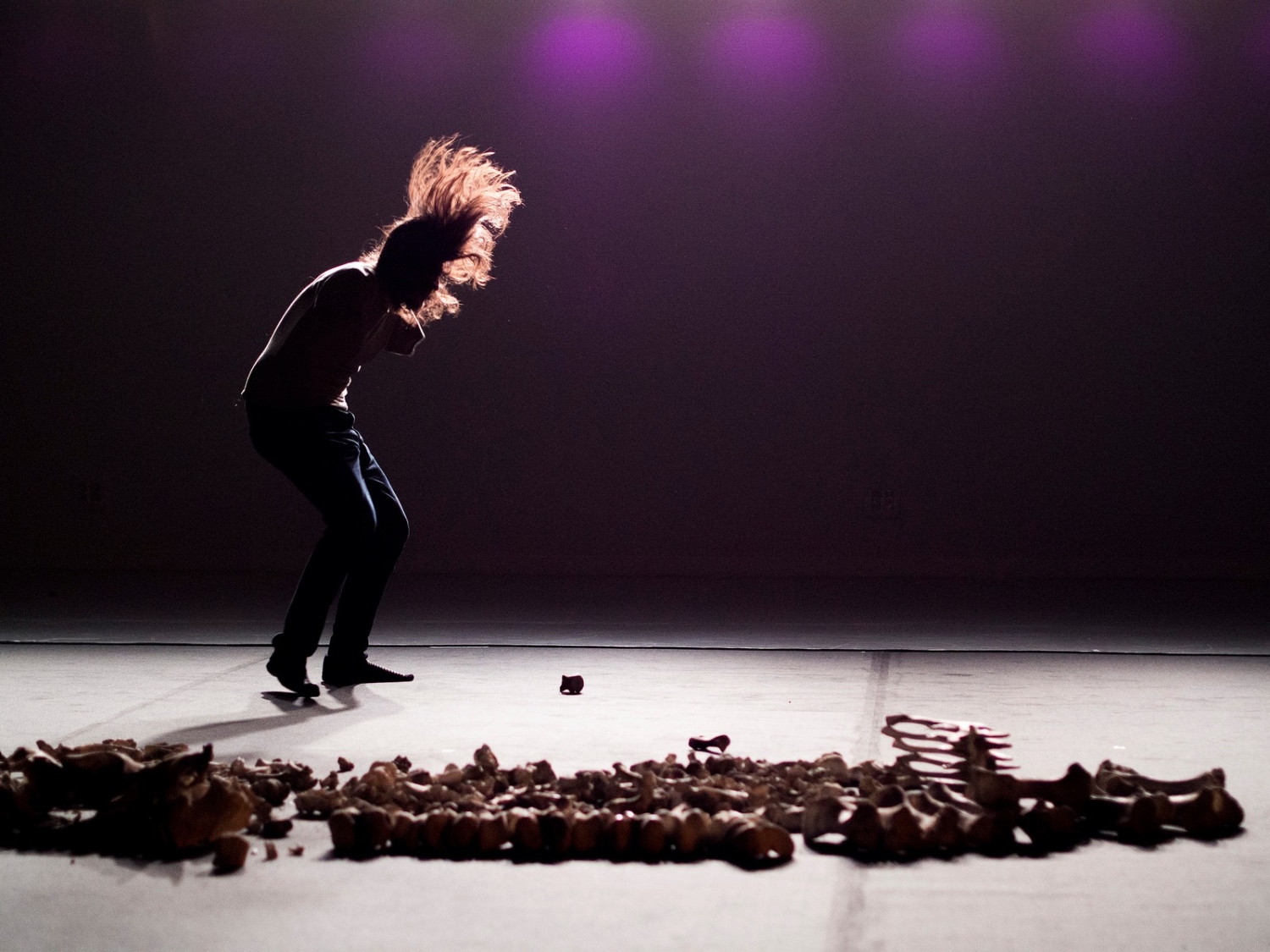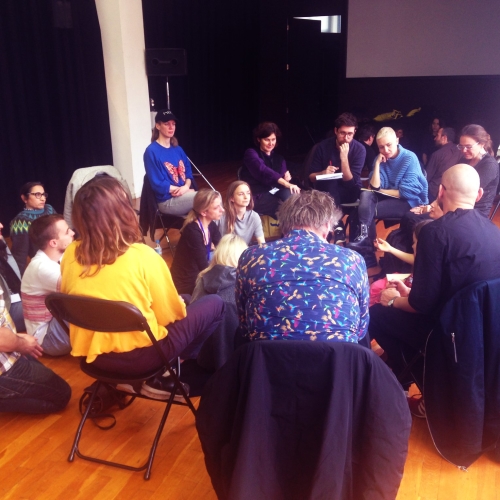

Taking place over two days, the event organised by EDN, Mercat de les Flors and Graner probed the relationship between dance artists and the institutions that support them. Participants were a mixture of artists, arts administrators, curators and directors from Spain and beyond.
DRAFF, living archive of performance making, reports on the Atelier.

An atelier diving into points of frictions in the artist-structure relationship
In February 2018, the European Dancehouse Network (EDN), Mercat de les Flors and Graner held an Atelier in Barcelona entitled ‘Artists and Structures: How do we transform ourselves?’ Taking place over two days, the event probed the relationship between dance artists and the institutions that support them. Participants were a mixture of artists, arts administrators, curators and directors from Spain and beyond.
Through a series of round table discussions and working groups, participants in the Atelier highlighted points of friction in the artist/structure relationship and opportunities for growth and change. A number of themes emerged and re-emerged, sticking points that the conversation circled around again and again. DRAFF took a ‘fly on the wall’ stance in the Atelier, making notes and looking for trends in the discussions. Overall, the Atelier uncovered issues rather than suggested solutions to these issues, but identifying and recording problems is a first step to addressing them.
The trends that DRAFF noted and the questions that were raised are recorded below.
A balancing act between institutions and individuals
It seems to have become accepted that the apparatus surrounding the art making will cost more than the art itself. Dance artists are slowly coming to question the fact that they often live below the poverty line while a large part of the funding allocated for making work is soaked up in the administration of institutions that present or produce the work. And that the individuals working in those institutions enjoy the security of a regular wage, sick pay, holiday days and the other benefits of a secure job – conditions which are right and proper. But is it possible to arrange the distribution of available funds in a more egalitarian way, allowing artists to enjoy a measure of security? This raises the more complex question of which artists will get to enjoy that security, and by what criteria. It’s certainly true that there are not enough resources to support all the artists that identify themselves as such.
Artists as, for and with citizens
Something that became clear over the two days of the Atelier is that publicly funded artists conceive of themselves as citizens, working for and with other citizens. This is a basic, but perhaps recently a forgotten, premise in the way we talk about artists and the public funding they receive. Being a citizen implies responsibilities in equal measure to entitlements, and it’s clear that artists feel that responsibility keenly. How they decide to execute that responsibility is their own decision and something that does not submit to a rigid value system.
And, just as artists have ‘citizenly’ responsibilities, so too do institutions. The balance of power at the moment lies with institutions, as decision-makers that can make or break artists’ careers. Is there a way to reframe the roles of each to equalise the distribution of power, to acknowledge their equal roles as citizen-actors?

The administration is a huge white elephant that is blind and deaf
A question raised repeatedly throughout the Atelier was whether institutions have become too bureaucratic, too inflexible in the way they respond to artists’ needs. It seems that both administrators and artists feel application forms are too long, too specific, too complex, and that the range of supports available is too limited and not responsive to the needs of each project. How is it possible to build institutions that are lighter, and more adaptable, to the ever-shifting demands of art-making? Is it possible to imagine a supportive structure that is unstructured? What would that look like? Could it be organised around concepts like ‘love’, ‘desire’ and ‘imagination’ rather than bureaucracy? How is this compatible with the need for transparency and accountability in what’s done with public money?
This question probably leads to a deeper discussion about how to decide whether money is being used ‘impactfully’ or not, and how impact is measured. Is it in terms of audience numbers? Is there another way to measure it? The thing contemporary dance performance provides is a space for individual, subjective responses. The idea of ‘measurement’ is at odds with this, since to measure something you must have an objective standard to compare it to.
So how do we reconcile something that’s a refuge from a financial value system – making art – with the demands of that very system? The arts are required to justify their cost in the terms of a system they essentially operate outside of.
Restrictions to artistic activities due to institutional positions
During the Atelier, we heard from Mathilde Monnier, the renowned choreographer who has also directed the Centre Chorégraphique National de Montpellier Languedoc-Roussillon for twenty years. Mathilde spoke about the restrictions placed on her artistic activities due to her institutional position. It was a surprise to many at the Atelier that artistic practice was not considered compatible with directing an institution. This sparked a conversation around the possibilities for arts institutions to be run by working artists. An obvious solution would be cooperative style organisations where responsibility for decision making and executing administrative tasks would be taken on by a group of working artists. Possibly, something that stands in the way of this coming to pass is the conception that artistic or creative ‘types’ are incapable of being organised and conscientious. Of course, anyone who has worked as or with an independent artist will know that the bureaucracy and precarity involved in the current system of funding for the arts requires artists to be deeply conscientious, hard-working, adaptable and quick to learn – which would seem to make them ideal candidates to run flexible and imaginative institutions.
Another repeated topic throughout the Atelier was the fact that much of the funding available is geared towards the ‘product’ that is produced by artists – in the case of dance, the show. In truth, the ‘output’, the ‘show’ is one point along a spectrum of activity undertaken by an artist – and not always the most important one. The pressure on artists to constantly output ‘products’ in this way bankrupts the creative impulse. Part of this pressure comes from the desire to confirm ‘value for money’. Again, does it make sense to talk about art in these terms? Do we need a new scale for measuring value in this area or, scarily, no scale at all? There was discussion around the idea of ‘intuition’ and other interpersonal skills being brought to the fore in assessing whether an artist is right for, say, a course of artistic study, or to join a company. This is a tricky proposition, as, with no objective scale of measurement, there seems to be no refuge for ‘fairness’.
These were some of the points raised over the course of the Atelier – the ones that stood out most clearly to the DRAFF team. The Atelier was a valuable starting point for a bigger discussion that needs to now progress to the question of how to address these issues.
Participants of "Artists and Structures" shared their view points on video. Discover how certain topics were approached in the five clips below.